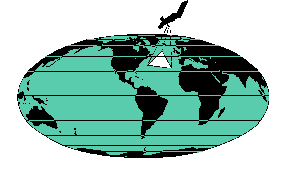 ©2020 Biological and Chemical Oceanography Data Management Office.
©2020 Biological and Chemical Oceanography Data Management Office.Funded by the U.S. National Science Foundation
One of the first major activities of JGOFS was a multinational pilot project, North Atlantic Bloom Experiment (NABE), carried out along longitude 20° West in 1989 through 1991. The United States participated in 1989 only, with the April deployment of two sediment trap arrays at 48° and 34° North. Three process-oriented cruises where conducted, April through July 1989, from R/V Atlantis II and R/V Endeavor focusing on sites at 46° and 59° North. Coordination of the NABE process-study cruises was supported by NSF-OCE award # 8814229. Ancillary sea surface mapping and AXBT profiling data were collected from NASA's P3 aircraft for a series of one day flights, April through June 1989.
A detailed description of NABE and the initial synthesis of the complete program data collection efforts appear in: Topical Studies in Oceanography, JGOFS: The North Atlantic Bloom Experiment (1993), Deep-Sea Research II, Volume 40 No. 1/2.
The U.S. JGOFS Data management office compiled a preliminary NABE data report of U.S. activities: Slagle, R. and G. Heimerdinger, 1991. U.S. Joint Global Ocean Flux Study, North Atlantic Bloom Experiment, Process Study Data Report P-1, April-July 1989. NODC/U.S. JGOFS Data Management Office, Woods Hole Oceanographic Institution, 315 pp. (out of print).

Lead Principal Investigator: Hugh W. Ducklow
Virginia Institute of Marine Science (VIMS)
Co-Principal Investigator: Dr John Martin
Moss Landing Marine Laboratories (MLML)
Contact: Cynthia L. Chandler
Woods Hole Oceanographic Institution (WHOI)
Data Manager: George Heimerdinger
Woods Hole Oceanographic Institution (WHOI)
BCO-DMO Data Manager: Cynthia L. Chandler
Woods Hole Oceanographic Institution (WHOI BCO-DMO)
U.S. Joint Global Ocean Flux Study [U.S. JGOFS]